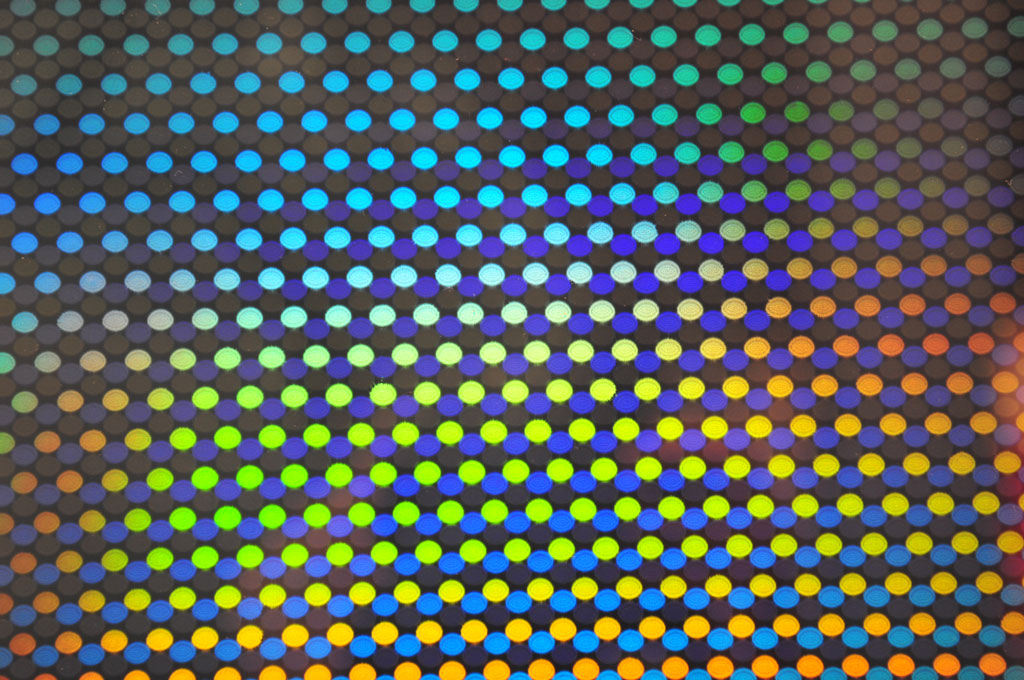ART-PRESENTATION: Dieter Jung-Between and Beyond
 Light, space and movement are at the center of the work of Dieter Jung, who has been dealing with the visual effects of color and light, surface and space since the mid-1960s. In order to make the cursory moment of optical phenomena visible, Dieter Jung uses both analog and digital techniques. Painting, drawing, printmaking and holography are in constant dialogue in his work.
Light, space and movement are at the center of the work of Dieter Jung, who has been dealing with the visual effects of color and light, surface and space since the mid-1960s. In order to make the cursory moment of optical phenomena visible, Dieter Jung uses both analog and digital techniques. Painting, drawing, printmaking and holography are in constant dialogue in his work.
By Dimitris Lempesis
Photo: ZKM-Center for Art and Media Archive
In addition to holograms, holographic mobiles and holographic light spaces, the exhibition “Between and Beyond” also includes Dieter Jung’s paintings, drawings and prints. Jung’s interest in the process of visual perception, the dual quality of light as particles and waves and the technical structure of images has accompanied him since his studies at the Hochschule für Bildende Künste in Berlin. Already in his first paintings he dealt with the representation of light and reflections. At the beginning of the 1970s, he painted a series of heads of well-known and unknown persons reminding of interference structures, in which the faces of Sigmund Freud, Ezra Pound and Friedrich Nietzsche are embedded in horizontally and vertically intertwining lines of oscillation, which, for Jung, initially made reference primarily to the textures of weaving art and the principle of warp and weft in the tapestries of the Renaissance. After studying holography at the New York School of Holography, Jung worked with leading scientists to develop a work that expanded the technical and artistic possibilities of holography, which the physicist Dennis Gabor discovered rather by chance in 1948, and made him one of the leading protagonists of holographic art internationally. For his first holograms Jung uses feathers found in 1977 in Central Park in New York, which float in space and cast their shadows as filigree objects in the holographic image. Subsequently he transferred the poems of Hans Magnus Enzensberger into the medium of holography, for which elaborate models had to be built in order to film them on a 360° turntable. In the series “Into the Rainbow”, “Gegenwartsräume” and “Inbetween” Dieter Jung creates abstract color spaces in the early 1980s using the holographic one-step technique discovered by Stephen A. Benton, in which the pure colors of the rainbow float freely in space. From 1985 to 1988 as a Research Fellow at the Center for Advanced Visual Studies (CVAS) at MIT in Cambridge, MA, directed by Otto Piene, Dieter Jung had extensive technical possibilities at his disposal with which he could explore new holographic methods for the replacement of the holographic image from its inherent object. In close exchange with scientists, the first computer-generated motion holograms are created there, in which enormous amounts of data were mastered for the time. In the “Light Mill (Motion in Space – Space in Motion)” series, diaphanous, mutually penetrating color surfaces rotate around three axes at different speeds. By moving in front of the hologram, the viewer activates the free-floating image sequences in space and is thus actively involved in the creation of the work. In his most recent light spaces and holographic mobiles Jung transfers the play with optical phenomena of light by means of lenses and mirrors into real space, which is thereby called into question for the viewer in his physical conditions. By floating the image in space, the ideas of Dieter Jung and other pioneers of holography, on which they have been working with their works since the 1960s and 1970s, would ultimately be fulfilled. It is the rainbows, mirages, reflections on glass, occasional bending of sunlight, floating shadows and other seemingly ordinary but somehow unfamiliar natural phenomena that set off Dieter Jung’s immense creativity. What Jung perceives from these phenomena forms the cornerstone of his art. He attempts to explore the truth of life in his works by representing his experiences with the transitions and transformations of light and shadow and sharing with the world what he finds touching and inspiring. He applies light and laser beams as his paints, and prisms, glass and screens as the canvas. With varying combinations of primary colors with circular, triangular and square structures, Jung has created a garden of light, luminous with flowing colors in which he would guides viewers to experience a trip of mystery back to the origins of art and, hence, to the truth of life lying behind light and shadow. The aim of the exhibition is to highlight the structural connections and interdependencies between the various strands of Dieter Jung’s work and to show the artist’s holographs and holographic mobiles in close exchange with his paintings and drawings. Against the background of current technological developments and increased interest in holographic techniques, the significance of his work for media history will thus be reassessed.
Info: Curator: Philipp Ziegler, ZKM-Center for Art and Media, Lorenzstraße 19, Karlsruhe, Duration: 9/2-2/6/19, Days & Hours: Wed-Fri 10:00-18:00, Sat-Sun 11:00-18:00, https://zkm.de





